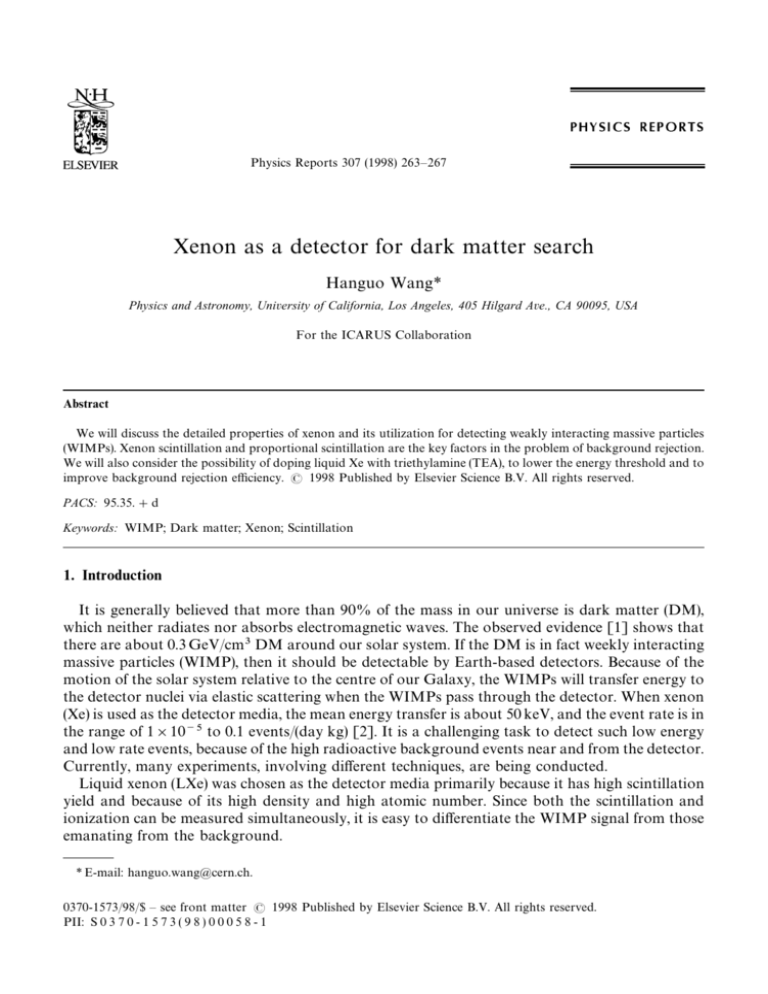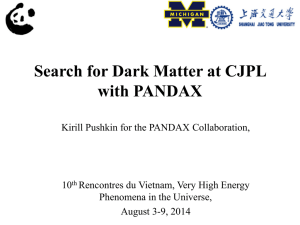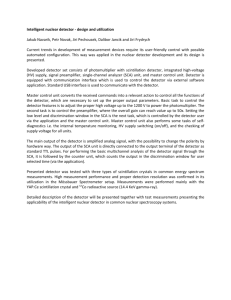
Physics Reports 307 (1998) 263—267
Xenon as a detector for dark matter search
Hanguo Wang*
Physics and Astronomy, University of California, Los Angeles, 405 Hilgard Ave., CA 90095, USA
For the ICARUS Collaboration
Abstract
We will discuss the detailed properties of xenon and its utilization for detecting weakly interacting massive particles
(WIMPs). Xenon scintillation and proportional scintillation are the key factors in the problem of background rejection.
We will also consider the possibility of doping liquid Xe with triethylamine (TEA), to lower the energy threshold and to
improve background rejection efficiency. 1998 Published by Elsevier Science B.V. All rights reserved.
PACS: 95.35.#d
Keywords: WIMP; Dark matter; Xenon; Scintillation
1. Introduction
It is generally believed that more than 90% of the mass in our universe is dark matter (DM),
which neither radiates nor absorbs electromagnetic waves. The observed evidence [1] shows that
there are about 0.3 GeV/cm DM around our solar system. If the DM is in fact weekly interacting
massive particles (WIMP), then it should be detectable by Earth-based detectors. Because of the
motion of the solar system relative to the centre of our Galaxy, the WIMPs will transfer energy to
the detector nuclei via elastic scattering when the WIMPs pass through the detector. When xenon
(Xe) is used as the detector media, the mean energy transfer is about 50 keV, and the event rate is in
the range of 1;10\ to 0.1 events/(day kg) [2]. It is a challenging task to detect such low energy
and low rate events, because of the high radioactive background events near and from the detector.
Currently, many experiments, involving different techniques, are being conducted.
Liquid xenon (LXe) was chosen as the detector media primarily because it has high scintillation
yield and because of its high density and high atomic number. Since both the scintillation and
ionization can be measured simultaneously, it is easy to differentiate the WIMP signal from those
emanating from the background.
* E-mail: hanguo.wang@cern.ch.
0370-1573/98/$ — see front matter 1998 Published by Elsevier Science B.V. All rights reserved.
PII: S 0 3 7 0 - 1 5 7 3 ( 9 8 ) 0 0 0 5 8 - 1
264
H. Wang / Physics Reports 307 (1998) 263—267
In fact the signal due to Xe nuclei recoil by WIMP elastic scattering behaves like a heavy
ionization signal inside LXe, while the signals from radioactive background are minimum ionising
signals. Therefore, for the signals from WIMPs and background, the scintillation/ionization ratios
of the total recoil energy are different [3].
The high density of Xe makes it easy to built a large-mass detector with a small structure and,
thereby, reduces the cost of the dectector shieldings. The high atomic number is especially good for
matching the high mass WIMPs kinematicly. The longest lifetime of the radioactive xenon isotope,
Xe, is about 36 days, and using enriched xenon [4], which is Kr-free, makes it possible to
construct a detector with extremely low background from the detector itself.
Within the Zeplin II [5] project, the UK RAL group is working on the initial phase of the
detector. This phase will only measure Xe scintillation and will use techniques that are similar to
those employed by the DAMA group [4]. Discrimination scintillation pulse shape will be
considered in this test, because the decay profile of the scintillation by Xe recoil is different from
that of the background signal [6].
Because the mean recoil energy is only around 50 keV, the ionization yield is too small for
readout by charge amplifiers. Proportional scintillation, which is scintillation caused by electrons
drifting under very high electric field around thin wires in LXe, makes it possible to measure the
ionization component from the low-energy gamma background [3]. Extensive studies have been
conducted with a 2 kg detector by the ICARUS group [3,7].
During the past two years, we have been studying the double-phase Xe detector that is installed
at CERN. The electroluminescence in gaseous Xe gives much higher light output and better
stability for the ionization measurement. The number of luminescence photons produced by one
electron under uniform electric field is well approximated by N "70;[(E/P)!1.0];dP [8].
Where P, E, and d are, respectively, gas pressure, electric field strength, and drift distance. By
drifting the ionization electrons from the liquid to the gas phase, the ionization component can be
measured by means of luminescence photons. As in the liquid-only case, the ionization components
can be measured by means of proportional scintillation photons. Fig. 1 shows the correlation plot
of primary versus secondary scintillation. It is shown clearly that the background rejection (left)
obtained by the double phase (liquid and gas) detector is much better than that obtained by the
single phase detector (right). A 99.8% rejection was obtained by the liquid-only phase; the double
phase is still under investigation.
Another possibility, which is also being studied at CERN, is to use double-phase Xe doped with
triethylamine (TEA)[(C2H5)3N] as the DM detector. The TEA acts as the internal photocathode
to convert the Xe primary scintillation photons into free electrons, which will then be transported
to the gas phase. Electroluminescence will take place when electrons are moving under very high
electric field in gaseous Xe. When uniform electric fields are provided in the drift region of the LXe,
the shape of the electron cloud can be maintained so that it gives a unique signal-to-background
discrimination.
2. The detector design
We will concentrate on the two-phase TEA-doped Xe detector. Because it collects primary light
much better, it has a very low energy threshold; it may also have a much better background
H. Wang / Physics Reports 307 (1998) 263—267
265
Fig. 1. Primary vs. secondary scintillation in double phase (left) and liquid-only phase detector (right).
Fig. 2. The proposed Zeplin II detector (left); the projected free electron on the X—½ plane perpendicular to drift (right).
rejection. A cross-sectional view of the proposed Zeplin II detector is shown in Fig. 2 (left). The
LXe is confined at the bottom, and the liquid surface is controlled so that it stays between two
(focusing and defocusing) plates (to be discussed later). In the gas phase, there are two additional
wire planes, which provide strong electric field for electroluminescence, with photon detection
devices placed above them. The detector is vacuum insulated with a double layer chamber. This
setup is common for both double-phase pure Xe and double-phase TEA-doped Xe.
266
H. Wang / Physics Reports 307 (1998) 263—267
Fig. 3. Structure of the focusing holes (left); proper electric field (right).
The ionising potential of TEA in LXe is about 5.9 eV. The photon absorption wave length for
TEA is peaked at about 170 nm, which is excellent for Xe scintillation, and the efficiency of the free
electron yield is almost 100% [9]. The absorption length of 40 ppm TEA-doped LXe is about 2 cm.
Xenon recoil nuclei will lose energy via scintillation. A 50 keV Xe recoil nuclei will lose all the
energy in a very short distance and, therefore, can be considered to be a point scintillation light
source. The scintillation photons will then be converted into free electrons by the TEA internal
photocathode, which will then be distributed around the event centre.
The process of energy loss of a radioactive event has significant differences from that of the recoil
events [3]. In the case of radioactive background, the total number of free electrons due to
ionization under normal electric field in LXe is comparable to the total number of free electrons
converted by the internal photocathode from primary scintillation. Conversely, the total number of
free electrons due to ionization by recoil nuclei is negligible. The result is that the final electron
distribution due to radioactivity has a centre core, but the recoil electrons will be relatively
smoothly distributed, as can be seen in Fig. 2 (right). This method enables background rejection on
an event by event basis. The main feature of this method is that the primary photon numbers are
amplified, resulting in a much better detection efficiency; hence, a low energy threshold can be
achieved.
Field-shaping rings are placed along the drift direction with one centimeter spacing; a focusing
plate is placed right below the liquid surface, and a defocusing plate is placed a few millimeters
above the liquid surface. The focusing plate is an 80 lm thick, three-layer, Kapton-insulated PCB
board, shown in Fig. 3 (left). Many small holes (400 lm in diameter) are chemically etched to form
the electron focusing structure. When the proper electric potential is provided on the electrodes,
these two plates will transport the electron from the liquid to the gas phase. The electric field is
shown in Fig. 3 (right). The electron transport was tested in a gas chamber, and the transparency is
better than 95%. The electroluminesence in the gas phase provides the amplification of the primary
signal with a controllable factor so that the quantum efficiency of the photon detection devices will
not play important roles for the overall detection efficiency and energy threshold.
H. Wang / Physics Reports 307 (1998) 263—267
267
This investigation is on going, and it is clear that the xenon detector gives us hope for
a large-scale detector that is suitable for mapping high-mass WIMPs. The Torino-UK-UCLA
project is dedicated to the task.
Acknowledgements
I wish to thank Dr. D.B. Cline, my PhD Thesis adviser, and Prof. P. Picchi and other ICARUS
members for their continuing support during the past few years.
References
[1]
[2]
[3]
[4]
[5]
[6]
[7]
[8]
[9]
R. Flores, Phys. Lett. B 126 (1983) 28.
R. Arnowitt, P. Nath, Phys. Rep. 307 (1998), this issue.
P. Bennetti et al., Nucl. Instr. and Meth. A 327 (1993) 178.
P. Delli, Nucl. Phys. B (P.S.) 48 (1996) 62.
D. Cline et al., UCLA proposal for NSF 98-2.
A. Hitachi et al., Phys. Rev. B 27 (1983) 5279.
H. Wang, CERN-UCLA, PhD thesis, in progress.
A. Bolozdynya et al., Nucl. Instr. and Meth. A 385 (1997) 225.
S. Suzuki et al., Nucl. Instr. and Meth. A 245 (1986) 78.








